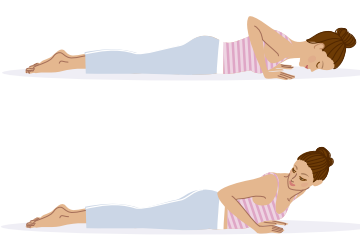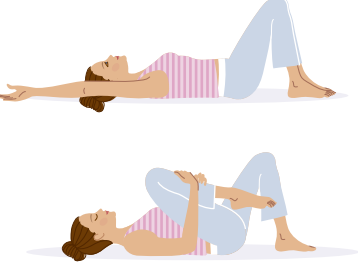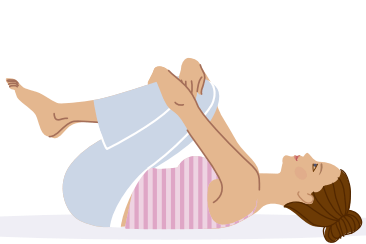Stress and anxiety promote abnormal gas production and abdominal pain. Relaxation techniques can be effective in remedying this, including yoga and self-massage.
belly yoga
This age-old practice is welcome for those who suffer from digestive disorders functional. It promotes relaxation by stimulating the parasympathetic nervous system and, thanks to certain postures, acts mechanically on the stomach by massaging it (postures in forward flexion), by untying it (postures in opening), by promoting good irrigation of the digestive organs and by accelerating elimination (inverted postures), by stimulating the colon (twists).
Here is a complete 15-minute session to release persistent abdominal tension, to be done anywhere, anytime, breathing freely, preferably through the nose and in full awareness.
The posture of elimination
To massage the belly and let go
lying on your back, knees to the chest, lay the cervical on the floor and stretch the lumbar well. Squeeze your knees between your arms. On the exhale, squeeze your knees even tighter to your abdomen.
To be performed over twenty breaths.
The half-cobra twist
To massage the visceral sphere by pressure and stimulate immunity by activating the intestinal flora.

Get down on your stomach, in the posture of the cobra, the hands flat on each side of the chest, the elbows at the level of the shoulder blades, tightly closed along the bust, the forehead on the ground.
On the inhale raise your head looking at the ground in front of you. On the exhale, turn the head to the left, inhale, bring the head back to the center, exhale, the forehead on the ground. Repeat the same movements, head to the right.
Repeat twice on each side.
The release of the winds
To release air in the belly and release mental and physical tension.

Lying on the back, the head on the ground in extension of the body, the bent legs, the feet behind the buttocks, the arms along the body. On the inhale, extend your arms behind your head. On the exhale, bring the arms forward then press one knee to the chest, the other foot remaining on the ground. Do the same with the other leg. Exercise to be repeated 7 times on each side (right leg then left).
Exercises taken from My belly yoga book, Andréa Budillon and Charlotte Blondel, Solar Editions, 96 pages, €7.90.
My belly massage session
In the East, the self-massages of the belly are commonly practiced in order to facilitate the movement of the intestinal transitreduce the bloating and other digestive discomforts… and to soothe the mind.
Head of care at Thalazur thalassotherapy in Bandol, Carole Thomas gives us simple and effective maneuvers to practice in the event of digestive disorders, stress or emotional upsets.
Avoid the hours following a meal corresponding to the digestion phase, and use a massage oil (for example, Puressentiel Belly Massage Oil, €14 for a 50 ml bottle). Wear loose and comfortable clothing. The posture to adopt: lying on your back, knees bent with a cushion underneath. Or get into a seated position, with your back aligned and your feet planted on the ground.
1. Pour a few drops of oil into the palm of your hand, and rub your palms together to warm them and bring energy (qi in Chinese medicine) to them.
2. Place your hands on either side of the navel. Feel the presence of your belly. Take three deep breaths. Inhale through your nose and feel your ribs expand to allow the lungs to fill with air. The lower abdomen swells, the diaphragm relaxes and lowers. On exhalation, the diaphragm rises upwards, the stomach relaxes and the lungs empty causing exhalation through the nose. “ This deep breathing will create an inner abdominal massage “says Carole Thomas.
3. Remove your left hand.
Keep only the right with which you make small waves from the right side of the belly, towards the left side. Unroll your hand well: the heel, the palm, the base of the five fingers to the pulp… The objective of the exercise, assures Carole Thomas, is to “ push the abdominal muscles in the direction of transit ”.
4. Then direct your right hand towards the solar plexus. Located in the middle of the hollow of the abdomen, below the point of the sternum, it is a center of energy sensitive to stress. Soften this area with small circular pressures in a clockwise direction.
5. Move towards the navel.
Massage its perimeter using circular movements, always in a clockwise direction.
6. Then massage the colon. Using the pad of your thumb, follow its path from start to finish. Exert pressure on the level of the lower right zone of the belly (the “ascending” colon) then go up towards the liver. Continue transversely (the “transverse” colon) and descend towards the lower left area of the abdomen (the “descending” colon).
7. In case of intestinal bloating, our expert advises focusing more on the area of the descending colon where gas is concentrated. “Raise them slightly by exerting pressure with the pulp of the thumb, then bring them back down in one go.”
Also to try…
– hypnosis It is known to relieve the abdominal paintransit disorders, in particular because it modifies cerebral activations in response to painful stimulation.
– Osteopathy The benefits seem to be felt in the short term (7 days) rather than in the long term.
– The meditation of mindfulness It aims to focus on sensations and thus reduce the mechanisms of pain.
– The sophrology It would make it possible to fight against the mechanisms of pain by visualization and digestive massages.
We want to give thanks to the author of this post for this incredible web content
Gas and abdominal pain: 3 yoga postures to relieve them
Visit our social media accounts and other pages related to themhttps://nimblespirit.com/related-pages/

